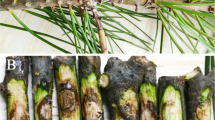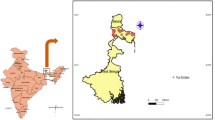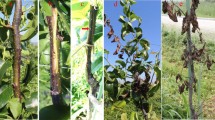Abstract
Bayberry (Myrica rubra) is a fruit tree native to the subtropical regions of China. It produces fruit with a unique taste and pharmacological characteristics, thus making it a widely cultivated tree commercially in many regions of China, including Zhejiang, Fujian, Guizhou, Sichuan and Yunnan Provinces. Recently, a twig blight disease occurred on the fruit tree and caused destructive damage of plantings in the Zhejiang Province. However, the etiology of the disease was unclear. This study was carried out to identify the causal agent(s) of the blight disease on bayberry. Fungal isolates were obtained from blighted twig samples collected from bayberry fields in Xianju, Rui’an, and Huangyan of Zhejiang Province. The majority (87.9 %) of the 257 fungal isolates were identified as Pestalotiopsis spp. based on their conidial morphology. DNA sequences of the internal transcribed spacer (ITS) region of the ribosomal RNA gene and the β-tubulin gene were obtained from six representative strains (XJ27, XJ42, RA2-1, YS26, YS44 and RA1-2) of the Pestalotiopsis spp. Phylogenetic analysis showed that three of the strains (XJ27, XJ42, and RA2-1) grouped with P. versicolor (Speg.) Steyaert while the other three strains (YS26, YS44 and RA1-2) grouped with P. microspora (Speg.) Batista & Peres. Pathogenicity tests in the greenhouse showed that all these six isolates of Pestalotiopsis spp. caused twig blight disease symptoms on bayberry plants, which were the same as observed in naturally infected plants in the field. Our results clearly indicated that P. versicolor and P. microspora were the major pathogens causing the twig blight disease on bayberry in southern China.




Similar content being viewed by others
References
CABI Bioscience Database 2012. http://www.indexfungorum.org/Names/Names.asp.
Cai, L., Jeewon, R., & Hyde, K. D. (2005). Phylogenetic evaluation and taxonomic revision of Schizothecium based on ribosomal DNA and protein coding genes. Fungal Diversity, 19, 1–21.
Cai, L., Jeewon, R., & Hyde, K. D. (2006). Phylogenetic investigations of Sordariaceae based on multiple gene sequences and morphology. Mycological Research, 110, 137–150.
Cai, L., Hyde, K. D., Taylor, P. W. J., Weir, B. S., Waller, J., Abang, M. M., et al. (2009). A polyphasic approach for studying Colletotrichum. Fungal Diversity, 39, 183–204.
Chang, T., Lim, T., Chung, B., & Kim, B. (1998). Studies on cultural characteristics Pestalotiopsis theae causing leaf blight on oriental persimmon tree. Korean Journal Plant Pathology, 13, 232–238.
Chen, C. Q., Zhang, B., Yang, L. N., & Gao, J. (2011). Identification and biological characteristics of round leaf spot on blueberry caused by Pestalotiopsis photiniae (in Chinese). Journal of Northeast Forestry University, 39, 95–98.
Duan, S., Sun, T., & Jiang, X. L. (2010). Identification of the pathogen for rot spot of Jatropha curcas and determination of fungicide toxicity (in Chinese). Jiangxi Forestry Science and Technology, 1, 37–39.
Evidente, A., Zonno, M. C., Andolfi, A., Troise, C., Cimmino, A., & Vurro, M. (2012). Phytotoxic a-pyrones produced by Pestalotiopsis guepinii, the causal agent of hazelnut twig blight. The Journal of Antibiotics, 65, 203–206.
Ge, Q. X., Chen, Y. X., & Xu, T. (2009). Flora Fungorum Sinicorum: Pestalotiopsis (in Chinese). Beijing, China: Science Press.
Glass, N. L., & Donaldson, G. (1995). Development of primer sets designed for use with the PCR to amply conserved genes from filamentous ascomycetes. Applied and Environmental Microbiology, 61, 1323–1330.
Guba, E. F. (1961). Monograph of Pestalotia and Monochaetia. Camb., Massachusetts USA: Harvard University Press.
Hu, H. L., Jeewon, R., Zhou, D., Zhou, T. X., & Hyde, K. D. (2007). Phylogenetic diversity of endophytic Pestalotiopsis species in Pinus armandii and Ribes spp. evidence from rDNA and β-tubulin gene phylogenies. Fungal Diversity, 24, 1–22.
Jeewon, R., Liew, E. C., & Hyde, K. D. (2002). Phylogenetic relationships of Pestalotiopsis and allied genera inferred from ribosomal DNA sequences and morphological characters. Molecular Phylogenetics and Evolution, 25, 378–392.
Jeewon, R., Liew, E. C., Simpson, J. A., Hodgkiss, I. J., & Hyde, K. D. (2003). Phylogenetic significance of morphological characters in the taxonomy of Pestalotiopsis species. Molecular Phylogenetics and Evolution, 27, 372–383.
Jeewon, R., Liew, E. C., & Hyde, K. D. (2004). Phylogenetic evaluation of species nomenculture of Pestalotiopsis in relation to host association. Fungal Diversity, 17, 39–55.
Keith, L. M., Velasquez, M. E., & Zee, F. T. (2006). Identification and characterization of Pestalotiopsis spp. causing scab disease of guava, Psidium guajava, in Hawaii. Plant Disease, 90, 16–23.
Kohlmeyer, J., & Kohlmeyer, V. B. (2001). Fungi on Juncus roemerianus 16. More new coelomycetes, including Tetranacriella gen. nov. Botanica Marina, 44, 147–156.
Lee, J. C., Yang, X. S., Schwartz, M., Strobel, G., & Clardy, J. (1995). The relationship between an endangered North American tree and an endophytic fungus. Chemistry & Biology, 2, 721–727.
Maharachchikumbura, S. S. N., Guo, L. D., Chukeatirote, E., Bahkali, A. H., & Hyde, K. D. (2011). Pestalotiopsis—morphology, phylogeny, biochemistry and diversity. Fungal Diversity, 50, 167–187.
Nag Raj, T. R. (1993). Coelomycetous anamorphs with appendage bearing conidia. Waterloo, Ontario, Canada: Mycol. Publ.
O’Donnell, K., & Cigelnik, E. (1997). Two divergent intragenomic rDNA ITS2 types within a monophyletic lineage of the fungus Fusarium are nonorthologous. Molecular Phylogenetics and Evolution, 7, 103–116.
Steyaert, R. L. (1949). Contributions à l’étude monographique de Pestalotia de Not. Et Monochaetia Sacc. (Truncatella gen. nov. et Pestalotiopsis gen. nov.). Bulletin du Jardin Botanique de l’État à Bruxelles, 19, 285–354.
Sun, H. T., & Cao, R. B. (1990). Identification of Pestalotiopsis parasitized on fruit crops (in Chinese). Acta Agriculturae University Zhejiangensis, 16, 179–185.
Sun, H. T., Chen, G. G., & Cao, R. B. (1990). Four new combinations of Pestalotiopsis in China (in Chinese). Acta Agriculturae University Zhejiangensis, 16, 151–154.
Sutton. (1980). The Coelomycetes. UK: Commonw. Mycol. Inst.
Tamura, K., Peterson, D., Peterson, N., Stecher, G., Nei, M., & Kumar, S. (2011). MEGA5: molecular evolutionary genetics analysis using maximum likelihood, evolutionary distance, and maximum parsimony methods. Molecular Biology and Evolution, 28, 2731–2739.
Tejesvi, M. V., Tamhankar, S. A., Kini, K. R., Rao, V. S., & Prakash, H. S. (2009). Phylogenetic analysis of endophytic Pestalotiopsis species from ethnopharmaceutically important medicinal trees. Fungal Diversity, 38, 167–183.
Wei, J. G., Xu, T., Guo, L. D., Liu, A. R., Pan, X. H., Zhang, J. C., et al. (2005). Delimitation of Pestalotiopsis species based on morphological and molecular phylogenetic characters (in Chinese). Journal of Guangxi Agricultural and Biological Science, 24, 304–313.
White, T. J., Bruns, T. L., Lee, S., & Taylor, J. W. (1990). Amplication and direct sequencing of fungal ribosomal RNA genes for phylogenetics. In M. Innis, D. H. Gelfand, J. J. Sninsky, & J. T. White (Eds.), PCR protocols: A guide to methods and applications (pp. 315–322). San Diego: Academic.
Zhang, X. Y., He, H., Hu, H. Q., Ou, X. C., Liu, F., & Li, X. S. (2009). Identification and biological characteristics of Rhizophora stylosa leaf spot caused by Pestalotiopsis versicolor (in Chinese). Acta Phytopathology Sinica, 39, 584–592.
Zhu, P. L., Ge, Q. X., & Xu, T. (1991). The perfect stage of Pestalotiopsis from China. Mycotaxon, 40, 129–140.
Acknowledgments
The authors thank Erik Heitkamp for proof-reading the manuscript. The research was supported by the Prior Project Fund for Agriculture of Zhejiang Province (2012C12009-5; 2009C12058), Funding for Public Service Sectors of Agricultural Special Projects (201203089), International Cooperation Project of Zhejiang Academy of Agricultural Sciences and Project 30970022 supported by NSFC.
Author information
Authors and Affiliations
Corresponding authors
Additional information
Hai-Ying Ren and Gang Li contributed equally to the work.
Rights and permissions
About this article
Cite this article
Ren, HY., Li, G., Qi, XJ. et al. Identification and characterization of Pestalotiopsis spp. causing twig blight disease of bayberry (Myrica rubra Sieb. & Zucc) in China. Eur J Plant Pathol 137, 451–461 (2013). https://doi.org/10.1007/s10658-013-0255-y
Accepted:
Published:
Issue Date:
DOI: https://doi.org/10.1007/s10658-013-0255-y




